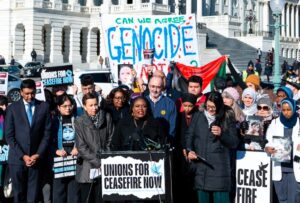This article appeared in Red Flag in Australia on August 1st.
When socialists in Australia try to understand mainstream US politics, they reason by analogy. The Republicans are the right-wing party akin to the Liberals or the Nationals, and the Democrats are the “center-left” party like the Labor Party. While this is a quick way of sorting out the two main parties in the US bipartisan system, it doesn’t adequately account for what is unique about the Democrats in the taxonomy of political parties across the democratic world.
The main point of separation between the Democrats and mainstream social democratic or labor parties is that the Democrats are a capitalist party—one of the two main capitalist parties that have governed the US since the Civil War era in the 1860s. Even the most right-wing social democratic parties, like the ALP or Starmer’s Labour in Britain, maintain some tentative organizational ties to the labor movement. Indeed, the history of those parties intertwines with the development of the labor movement and the unions’ attempts to create some type of political organization to represent their interests.
No such history attaches to the Democrats. It originated in the 1790s as a parliamentary faction of supporters of Thomas Jefferson, then secretary of state (foreign minister) and, later, the US’s third president. While the details of its emergence in a fight over a proposed treaty with Britain are not important here, what is important is the base on which Jefferson and his supporters rested: the slave-owning planter elite in the southern states. For most of its history, the Democratic Party has been the political vehicle of, first, the southern slaveholders; second, the Confederate States of America, whose secession in defense of slavery precipitated the 1861-65 Civil War; and third, the southern politicians who defended the Jim Crow system of racial segregation and lynch law into the 1960s.
The organization called the Democratic Party didn’t exist until the 1820s, around the same time that the first instances of workers’ organizations and political parties emerged in cities like Philadelphia, Boston and New York in the industrializing northern states. The key figure for this era of the Democratic Party was Andrew Jackson, a wealthy slaveholding planter and former general. To Marxist Harry Braverman, Jackson was in many ways the founder of the modern Democratic Party. “Jacksonian democracy” pioneered many of the trappings of modern democratic politics: mass electioneering, urban patronage machines (especially New York’s Tammany Hall), political conventions and party primary elections.
Jacksonian democracy promoted nearly universal white male suffrage to extend the planters’ reach into national politics, as Braverman noted:
“The planting class, resting on unorganized, unrepresented, almost unmentioned slave labor, could afford to countenance reforms which struck against the Northern capitalists. The ten-hour day for workers, extension of the vote to the working class, attacks upon the factory system and other such agitations, typical of the Jackson period, represented no direct economic threat to the planters.”
At a time when, in other capitalist countries, workers’ organizations were fighting for democratic rights and political representation, the US system had begun the process of integrating working-class white voters into the existing system.
The Civil War ended the South’s domination over national politics, with the victors’ party, the Republicans, dominating national politics for the next 70 years. The Democrats shrank to a regional party of racist Southern politicians, with a few Northern outposts such as New York, where immigrant workers formed a large part of its voting base. Only in the 1930s, when mass strikes created industrial unions, was national politics transformed again.
The Democrats’ contemporary reputation as the “party of the people” follows from the New Deal period (1933-45), in which the Democratic administration of President Franklin Roosevelt (FDR) enacted important social reforms, such as social security and the right to form unions. The 1960s “Great Society”, under which Democratic administrations inaugurated Medicare (medical insurance for seniors and disabled people) and the “War on Poverty”, solidified the identification of the Democratic Party with “the people”.
Neither period of twentieth-century social reform originated with the Democrats. At best, the Democrats responded to mass movements pressing for social change. FDR famously called himself “the best friend the profit system ever had” when he explained why he endorsed social reform in the face of the Great Depression and a mass labor movement. Similarly, Democratic presidents Kennedy and Johnson put federal power behind civil rights and anti-poverty demands—abandoning the racist southern Democrats to the Republican Party—when mass civil disobedience and urban rebellions swept the country.
From the 1930s through the 1970s, the Democrats were the main governing party of US capitalism. During that time, Democratic administrations led the US to superpower status through the Second World War, erected the postwar national security state, inaugurated the atomic age, and created the postwar US-dominated global economic order. While Democratic Party supporters might think of it as the party of Medicare and Social Security, it is equally the party of Hiroshima and Nagasaki, the CIA, the World Bank, the Vietnam War and the internment of Japanese Americans during World War II.
This history of Democratic reform on behalf of “the people” spans only about 40 of the 160 years since the Civil War. Even in the last generation, when working-class living standards have declined from their peak in 1973 and unions have been destroyed, the Democrats have done little for workers.
At the end of Biden’s current term, Democratic administrations will have held the White House for 20 of the last 32 years. They have won the popular vote in seven of the last eight presidential elections (although they lost two of those elections due to the undemocratic Electoral College system). Yet the US is no closer to having a national health system than when it was first proposed in the 1930s, and the Supreme Court has stripped away voting rights and the right to abortion. US income inequality is more extreme today than it was in 1963.
“Part of the reason survival-of-the-fittest periods are so relentless … rests on the performance of the Democrats as history’s second-most enthusiastic capitalist party. They do not interfere with capitalist momentum, but wait for excesses and the inevitable popular reaction”, wrote the late Kevin Phillips, author of The Emerging Republican Majority, a former Republican operative who turned against the dominant conservatism of the 1980s Reagan era.
The Democrats countenance more liberal social policies and (sometimes) rudimentary business regulation. Republicans tend to lean on support from religious and cultural conservatives to bolster their more open endorsement of restrictions on immigration and tax cuts for the rich. Nevertheless, the Democrats are, at their core, an elite party concerned with sharing the responsibility of ruling the United States with the Republicans. The differences that separate the two parties are minor compared to the fundamental commitments that unite them.
As socialist scholar and activist Kim Moody, writing after the 2020 election, put it:
“The Democrats are not some kind of old-fashioned workers’ party that conducts political education to raise people’s consciousness. They, like the Republicans, appeal to the voters’ existing instincts, prejudices, and preferences—in this case a combination of moderate social liberalism and reforms that avoid economic redistribution, higher taxes, or implied threats to private property, property values, or privileged school districts. They are the party of alt finance, Wall Street, the media, Silicon Valley, much of the military-industrial complex, and the prosperous.”
The Democratic Party, like the Republican Party, plays the role of helping big business to articulate its priorities through government while maintaining the power and stability of the political status quo. For the ruling class, the benefit of the two-party system is this: if one party falls out of favour with the voters, the other, with predictable policies, is waiting in the wings. It helps to explain why the “party of the people” often carries out the wishes of big business or the military-industrial complex instead.
Although the Democratic Party is one of the longest-existing mainstream parties in the world, it doesn’t really compare to many of the world’s political parties on the most basic levels. It has no fixed membership or membership requirements. Voters are Democrats if they vote for Democrats in elections.
The closest approximation to a “program” is the party platform approved at the national convention every four years. As party conventions have developed into little more than trade shows rolling out that year’s model (the presidential candidate), the party platform is usually synonymous with the candidate’s talking points. In any event, Democratic Party candidates—from the presidency to the city council—are free to follow or to ignore the party platform in their election campaigns.
The party has no official political leadership outside of its candidate for president and important Democratic congressional officials. The Democratic National Committee (DNC) comprises the chairs and vice-chairs of each state or territory party, plus around 200 elected politicians, union leaders, lobbyists and campaign donors. The DNC exists to set rules for nominating candidates and to raise money for them. Democratic officeholders select “at-large” DNC members. The average rank-and-file Democratic voter plays no role in electing any of these leaders, much less hopes to become one of them.
Even in places like Chicago or New York, where Democrats dominate local government and Republicans haven’t won office for decades, there are no genuine Democratic Party branches or membership meetings. Outside of electioneering seasons, the Democratic Party functions more like the local Rotary Club or Chamber of Commerce than like a political organization.
Because the Democratic Party appears “structureless”, much of the political left in the US has taken a flawed approach to it. One aspect of this is the notion that the party is simply a label on electoral ballots (or “ballot lines”) that socialists or activists can lay claim to. This has been a central argument of the reformists around the Democratic Socialists of America and their associated journals, such as Jacobin and Catalyst.
Another aspect of this flawed approach is the notion that the Democratic Party is permeable, and because of this, committed activists and social movements can work within its minimal structures to take it over. In the postwar period, the socialist forebears of today’s DSA pursued what they called a strategy of “realignment” whereby the labor and civil rights movements and allied liberal Democrats would push the party’s reactionary southern wing out, leaving the Democrats as a quasi-social-democratic party.
Both of these arguments miss the more significant point that the Democratic Party is a top-down organization that is quite capable of acting monolithically, especially when challenged by even the vaguest whiff of “left” or unconventional politics. Within about three days during the presidential primaries in 2020, party bosses resurrected Joe Biden’s moribund campaign, prevailed on several of his chief rivals to drop out of the race, and coalesced against the challenge from the self-described socialist Senator Bernie Sanders. Today, there is no inner party revolt against Biden’s policy of support for Israel’s war in Gaza, even while opinion polls show that upwards of 75 percent of Democratic voters disapprove of Israel’s actions in the war.
Democratic electoral fundraising committees, which can deploy millions of dollars in the US’s increasingly expensive electoral system, have huge influence over which politicians can run as Democrats.
Even if someone like DSA member Alexandria Ocasio-Cortez (AOC), a representative from New York, manages to win election, the party and congressional leadership have many ways of making them conform to the liberal capitalist consensus. AOC has gone from an over-hyped “insurgent” to a Biden surrogate in not even three two-year terms in Congress. For generations, activists (including many far more radical than AOC) who became Democratic politicians to “change the party” found instead the party changing them.
The US system of financing elections, in which corporations and rich individuals have virtually unlimited ways to pour millions of dollars into the coffers of the capitalist parties, is a means to cement capitalist control of the political system. In the 2020 presidential election, the Biden campaign and its supporters raised and spent more than $1.6 billion, compared to about $1 billion for Trump. About $27 million of the Democratic haul (or less than 2 percent) came from labor unions. The finance, insurance and real estate industries contributed about ten times as much as labor unions.
Labor unions may contribute thousands of member hours to “get out the vote” operations for the Democrats, but the statistics in the paragraph above should underscore why ideas of taking over Democratic “ballot lines” or the party misunderstand whose class interests the party represents.
Still, liberals and Democrats have many rich patrons. This money often flows through tax-exempt “outside groups”, non-governmental organizations that lobby and support politicians. Some of these groups, like the civil rights organization the National Association for the Advancement of Colored People, have roots in advocacy. Others are simply Democratic Party-aligned “activist” groups whose actions are transparently electoral. But they, which eco-socialist Howie Hawkins described as organizations of “professional liberals”, provide a key prop to the modern-day Democratic Party:
“[Professional liberals include] … the paid staff and leaders of the unions and the big environmental, peace, civil rights, women’s, gay, and community organizing groups. Selling out to the Democratic Party pays off for the professional liberals in the form of career opportunities and funding. These material benefits flow through social and organizational networks that connect the professional liberals in nongovernmental organizations (NGOs) to their peers in Democratic administrations and the corresponding party organizations that are built from the top down by Democratic patronage and preferment. Corporate funding—grants for the NGOs, universities, and progressive media, and campaign cash for the Democrats—cements it all together, co-opting institutionalized progressivism into the service of the corporate-dominated Democratic coalition.”
The Democratic Party may be an institution of capitalist rule, but capitalists don’t mobilize voters as effectively as the local trade union official or immigrant rights leader does. Those activists are critical to the entire operation of liberalism in American politics. This is not just because they’re the people who get out the vote on Election Day, but also because they’re the ones who give Democratic Party liberalism any appeal to a social base.
But more often than appealing to a vision of a better future for working people is the Democrats’ campaigning on the threat of a Republican victory. Every successive election becomes “the most important election of our lifetimes”, which requires voting for the Democrats. With the Republicans projecting an increasingly authoritarian and repressive politics, today’s Democrats can always position themselves as the “lesser evil”.
Socialists understand that the Democratic Party is the default option for millions of Americans who want positive social change. Indeed, the two-party setup of mainstream American politics practically forces this choice. Elections, with few exceptions, are run as “winner-take-all”, and legal barriers for third parties to gain ballot access are onerous. Independent parties committed to popular and pro-working-class policies in the US have been rare. But thousands who have started participating in Democratic politics—from anti-war activists in the First World War to labor activists in the 1930s and civil rights activists in the 1960s—have found that the Democratic Party is not an effective vehicle for genuine social change.
Although both ruling parties in the US have undergone major changes over the years, the Democratic Party is the ultimate chameleon in the two-party system. The party that spawned the Confederate States of America was, by 2008, the party of the first African American president. For most of the last century, it has served a particular role in the two-party system. It is the party that encourages the loyalty of oppressed and exploited groups in US society—Blacks, union members, women, immigrants, LGBTQ folks—only to contain and blunt their aspirations for a more fundamental reordering of capitalist priorities.
In times of great social crisis, such as that which confronted the Roosevelt administration in 1933, the Democrats can shift “left” to appeal to mass discontent with the system. The Democrats’ skill in using these means to coopt labor unions and other social movements to their agenda remains one of the chief reasons why no labor or a social democratic party exists in the United States.
When elections roll around, Democratic politicians operate on the assumption that the left and its “base” “have nowhere else to go”. If the left doesn’t build an alternative, workers and oppressed people will continue to face an electoral choice between “terrible” (the Republicans) and “not as bad” (the Democrats). Recognizing the Democratic Party as one of the chief pillars of a system that maintains exploitation and oppression in US society is the first step toward building a socialist alternative to it.
Lance Selfa
Lance Selfa is the author of The Democrats: A Critical History (Haymarket, 2012) and editor of U.S. Politics in an Age of Uncertainty: Essays on a New Reality (Haymarket, 2017).




